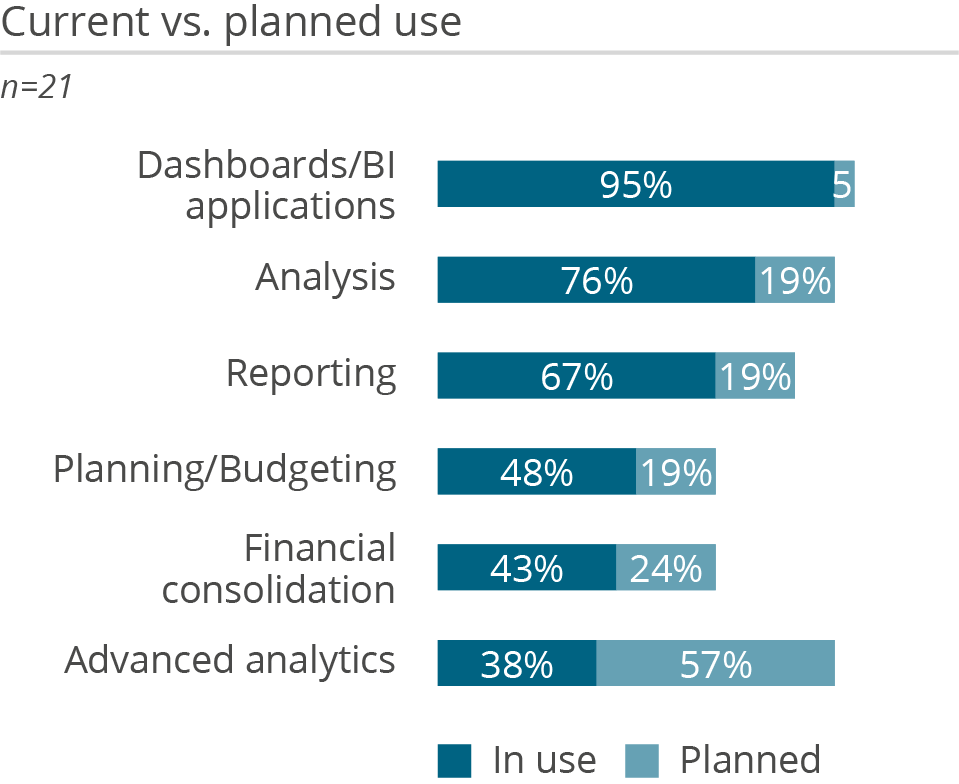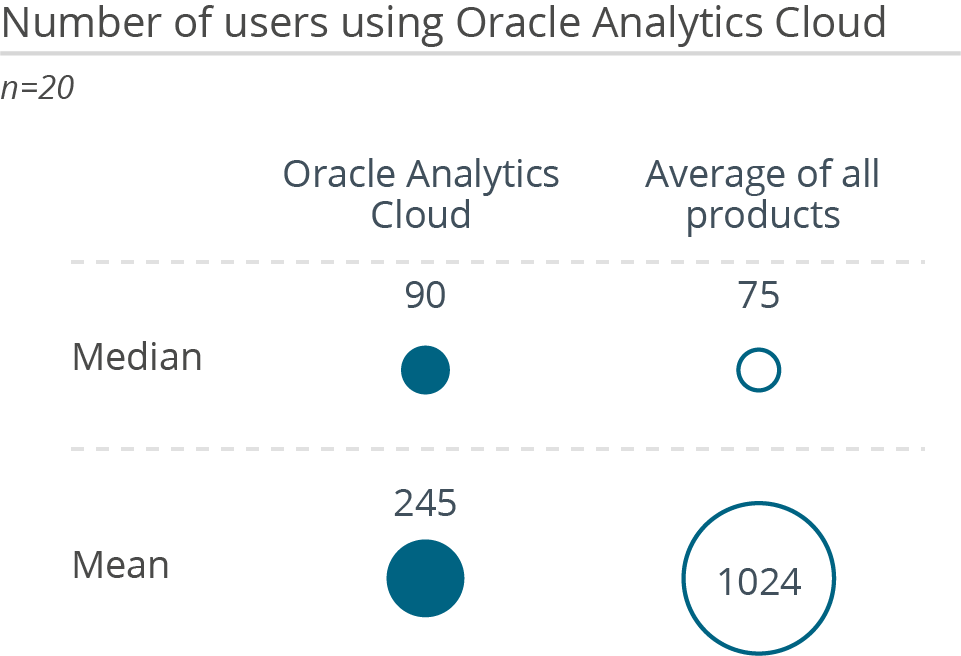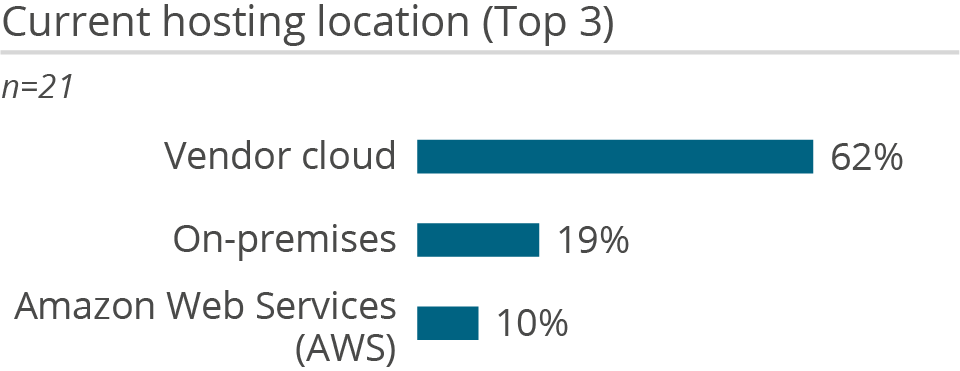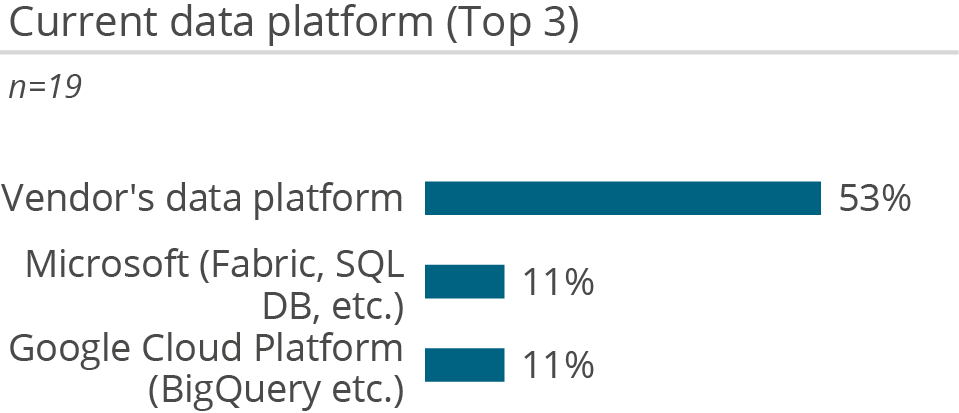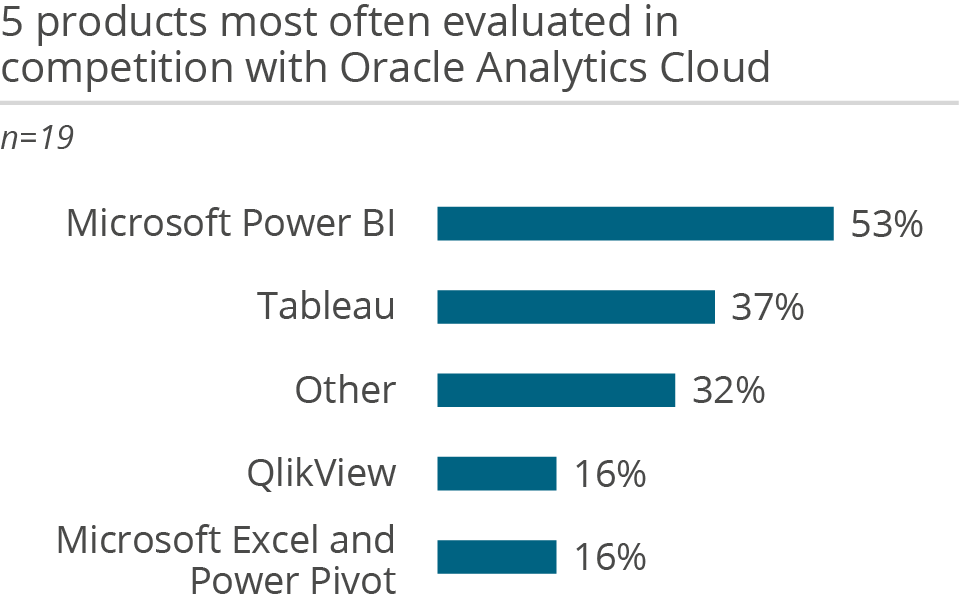Oracle Analytics Cloud
What is Oracle Analytics Cloud?
Suite for reporting, dashboards and analysis. Predefined content created with OAC available. Oracle Analytics Server available as an on-premises version (functions are adjusted annually).
About Oracle Analytics Cloud
Self-description of the vendor
Would you like to find out more about BARC reviews? Our FAQs answer the most important questions.
Oracle Analytics Cloud BARC Review & Rating
Provider and product description
Oracle is a global provider of enterprise cloud computing, offering software, platform, infrastructure and even data as a service. With over 160,000 employees, Oracle is one of the giants in the market.
The Oracle Analytics offering rests on three major pillars: Oracle Analytics Cloud (OAC), Oracle Analytics Server (OAS) as well as predefined content and embedded analytics created using OAC, combined into the Fusion Data Intelligence offering.
OAC is Oracle’s flagship product for BI & analytics. The suite runs on Oracle Cloud Infrastructure (OCI) and can leverage OCI services such as Autonomous Data Warehouse. Oracle Analytics Server, the on-premises version of OAC, brings the capabilities of the cloud platform annually to organizations requiring on-premises deployments or wanting to run it in other clouds. For Oracle’s business application customers, Fusion Data Intelligence (FDI) combines predefined content built using Oracle Analytics Cloud and the OCI Data Lakehouse that equips customers with preconfigured connectivity to Oracle Cloud Applications as well as options to connect to third-party data. Besides that, the product serves customers with prebuilt AI content including ready-to-use models configured to support a specific operational task such as predicting sales order delivery. In addition, FDI is the basis for a range of intelligent applications that Oracle says go beyond dashboards and reports with prebuilt insights and AI/ML-driven recommendations to facilitate decisions and actions by role, task and industry. FDI is part of a range of OAC-based SaaS apps designed for organizations using other Oracle application offerings, such as Oracle NetSuite, Oracle Health etc. It was announced at Oracle Cloud World 2025 that OAC has been integrated into the Oracle AI Data Platform.
Oracle Analytics Cloud is a platform for dashboards, formatted reports, ad hoc reports, analysis, data preparation and machine learning. It offers different clients for different user types. Business users typically work with the modern web-based environment, which offers augmented data preparation and custom data transformations via Data Flows as well as visual analysis features. More mature clients, such as Answers (ad hoc reporting) and Publisher (for developer-oriented pixel-perfect reporting), still exist and are equipped with the same visualization engine. Mobile clients are also available.
All the clients can connect to Oracle’s enterprise semantic layer, which offers strong calculation and caching features and a common and governed business logic. The suite typically connects directly to underlying data using native connectors, OEM software, REST APIs or standards such as OData and JDBC/ODBC without replicating data. A semantic modeler (i.e., a web-based environment for creating SMML-based models) is now the main development environment for this layer. SMML is a JSON-based Semantic Modeler Markup Language that describes the semantic model’s objects. The model is integrated with Git to support software development and facilitate deployment, maintenance and version control. Moreover, Oracle’s semantic layer is open to be consumed by third-party applications such as Power BI. For openness, Oracle offers REST APIs for Oracle Analytics to provide developers with access to functionality in OAC. The vendor also provides a story exchange format, which allows customers to integrate with third-party video GenAI services to provide interactive and spoken stories using AI.
Business users can use the semantic layer, which is typically created by technically savvy users, or create their own data models (data sets). Oracle offers a self-optimized in-memory engine, which is used to ingest and cache data instead of connecting live to sources, making it a compelling option to boost performance and productivity without leaving the governance delivered by the platform.
With ‘Auto Insights’ and ‘Explain’, users can leverage automated insights generation powered by ML and NLG. Relevant drivers, patterns and clusters are identified and visualized. Beyond that, forecasts leveraging weighting algorithms can be created based on the drivers identified. Natural language queries (‘Ask’) can be used to analyze data without deep technical expertise or having to search across all data sets cataloged in many supported languages. Moreover, ‘Oracle Analytics AI Assistant’ – a GenAI assistant for analysts – is now generally available. The integration with Oracle CIoud Infrastructure (OCI) AI Services brings an additional set of AI-powered capabilities, such as document interpretation, to OAC.
Complementing the portfolio, machine learning algorithms are embedded out of the box with Oracle Analytics Cloud. R and Python scripts can be embedded to leverage the results of advanced analytics models. Additionally, ML algorithms embedded in Oracle databases can be leveraged without shifting data, providing enhanced speed and flexibility for analytics.
Strengths and challenges of Oracle Analytics Cloud
BARC’s viewpoint on the product’s strengths and challenges.
Strengths
- Cloud and web-based platform for reports, analyses, visualization and dashboards. Also includes powerful and easy-to-use data preparation with good data profiling and user guidance through recommendations for transforming and enhancing data.
- SMML-based semantic layer which provides a governed and trusted view of data (also for third-party tools such as Power BI) and facilitates modern software development workflows through its integration with Git.
- Oracle offers the possibility to build independent self-service data sets for high flexibility as well as weaving semantic models together for a consistent enterprise-wide view.
- Automated insights based on ML and ‘Ask’ NLQ as well as the Oracle Analytics AI Assistant drive acceptance and lower the barrier for business users to use analytics by helping them to find relevant signals for decision-making.
- The integration with Oracle Cloud Infrastructure (OCI) AI Services enhances the AI capabilities within the platform and means that business users do not need to leave the platform, for example, to analyze unstructured data like pictures or documents.
Challenges
- OAC is only available on Oracle Cloud. Customers seeking to deploy it on other cloud services must use OAS, which only receives functional updates once per year and must be managed by the customer.
- Data models created by business users cannot be easily deployed to the central semantic layer as the data modeling environments are only partially integrated.
- Integration between Publisher and Visualize is at data level only, reducing efficiency when creating content and making it harder for business users to leverage complete functionality.
Oracle Analytics Cloud User Reviews & Experiences
The information contained in this section is based on user feedback and actual experience with Oracle Analytics Cloud.
The information and figures are largely drawn from BARC’s The BI & Analytics Survey, The Planning Survey, The Financial Consolidation Survey and The Data Management Survey. You can find out more about these surveys by clicking on the relevant links.
Who uses Oracle Analytics Cloud in a BI & analytics context and how
Why users buy Oracle Analytics Cloud and what problems they have using it

- Get independent information on software solutions, market developments and trends in data, analytics, business intelligence, data science and corporate performance management.
- Make data & analytics decisions based on numbers, data, facts and expert knowledge
- Access to all premium articles and all our research, including all software comparison studies, scores and surveys.
- Unlimited access to the BARC media library
- Consume unlimited content anywhere
Full user reviews and KPI results for Oracle Analytics Cloud
All key figures for Oracle Analytics Cloud at a glance.
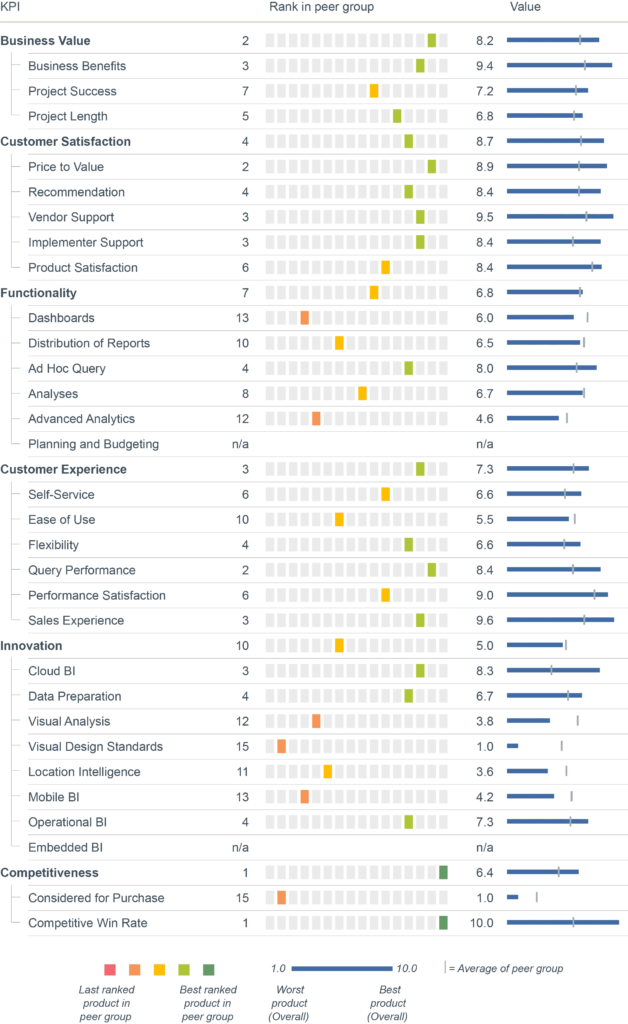
- Get independent information on software solutions, market developments and trends in data, analytics, business intelligence, data science and corporate performance management.
- Make data & analytics decisions based on numbers, data, facts and expert knowledge
- Access to all premium articles and all our research, including all software comparison studies, scores and surveys.
- Unlimited access to the BARC media library
- Consume unlimited content anywhere
Individual user reviews for Oracle Analytics Cloud
Number of employees
Industry
Source
What do you like best?
Great product. Checks all the boxes for an enterprise-level BI solution.
What do you like least/what could be improved?
There can be a performance issue when using subject areas with many attributes.
What key advice would you give to other companies looking to introduce/use the product?
Spend appropriate time upfront planning data and reporting requirements.
How would you sum up your experience?
Very satisfied.
Number of employees
Industry
Source
What do you like best?
It has a lot of potential, but the data organization and clean data have to support the front-end capabilities. Creating simple dashboards is easy.
What do you like least/what could be improved?
Reporting with any amount of formatting is cumbersome. It is also somewhat expensive to put in the hands of too many people.
What key advice would you give to other companies looking to introduce/use the product?
Make sure you ask them to show you a system at another company implemented with similar data structures, feeds, complexity of formatted data, as well as sheer size of data.
How would you sum up your experience?
It's a nice tool if you want quick dashboards without a lot of complexity.
Number of employees
Industry
Source
What do you like best?
Ease of access, integration with client requirements, and fast, efficient delivery of deployments.
What do you like least/what could be improved?
–
What key advice would you give to other companies looking to introduce/use the product?
Working as an Oracle Analytics consultant for six years, I have come across many challenges in client deliverables. There have been times when a few things couldn't go as planned due to roadblocks in implementation. Oracle Analytics helps me achieve those with a clear solution offering platform. I would always recommend using Oracle Analytics for any analytics solutions.
How would you sum up your experience?
Reliable, fast, and accurate in delivering data; less time needed to adapt any analytics skills across Oracle.
Number of employees
Industry
Source
What do you like best?
Accommodates a variety of sources and allows data transformations within the tool using data flows.
What do you like least/what could be improved?
Some features that should be basic requirements are not available (i.e., user/role reports, data lineage reports, ordering prompts, etc.). For users, navigation can be confusing—for example, right-clicking to go to drill-down reports.
What key advice would you give to other companies looking to introduce/use the product?
Solid option that can likely accommodate an organization's primary needs. Implementation will require technical expertise in the tool. Once implemented, functional users may be able to create their own datasets and build reports.
How would you sum up your experience?
Generally good.
Number of employees
Industry
Source
What do you like best?
Simple but powerful.
What do you like least/what could be improved?
–
What key advice would you give to other companies looking to introduce/use the product?
Build a proof of concept first.
How would you sum up your experience?
Very good tool. Not the most powerful, maybe, but quite easy and fast to create solutions that deliver value to users.
Number of employees
Industry
Source
What do you like best?
Integrated with Oracle OCI.
What do you like least/what could be improved?
Runs only on OCI.
What key advice would you give to other companies looking to introduce/use the product?
If they have Oracle tech and Cloud ERP from Oracle, then it is easier to use.
How would you sum up your experience?
Overall, a robust product with a good metadata modeler.
Number of employees
Industry
Source
What do you like best?
Iin comparison with the built-in OTBI tool in sales cloud it is much more flexible in building data models, subject areas and applying business logic.
What do you like least/what could be improved?
Upgrades tend to initiate issues and solved issues cause new issues. The tool is still in a lot of development and that makes it not 100% reliable.
What key advice would you give to other companies looking to introduce/use the product?
Oracle Analytics Cloud is a great tool and has added value for your organisation if your audience is actually using the dashboard. As a tool for exporting data (which most users do), it is to valuable.
How would you sum up your experience?
Great tool with lots of flexibility for data modelling and ideal native connection with the fusion cloud instances.
Number of employees
Industry
Source
What do you like best?
Oracle cloud provides great support and great leading technology to support the movement of BI tools.
What do you like least/what could be improved?
Currently the performance of loading a large detail table is taking too long. When using multiple facts and dimensions there is a big slow down that we have notice.
What key advice would you give to other companies looking to introduce/use the product?
Oracle cloud has not just great resources, but the community in itselfs is one thing that I am proud to be a part of.
How would you sum up your experience?
This is an overall great product that if the performance is fixed and the momentum keeps up, will be the leading platform in BI tools.
Number of employees
Industry
Source
What do you like best?
As an analytics professional with over 30 years of experience, I can confidently say that Oracle Analytics Cloud is the most versatile analytics platform I have ever used. Its ability to consolidate all ERP data into one centralized location is a game-changer. With Oracle Analytics Cloud, users can seamlessly perform self-service visualizations and create high-pixel traditional reporting dashboards, making data analysis and reporting more intuitive and efficient. One of the standout features of Oracle Analytics Cloud is its cloud-based nature. This eliminates the need to worry about software updates, as they are managed automatically, ensuring that we always have access to the latest features and improvements. This significantly reduces the administrative burden, allowing a single full-time equivalent (FTE) to efficiently manage the entire system. The development cycle with Oracle Analytics Cloud is remarkably fast, enabling quicker turnaround times for analytics projects and facilitating agile responses to business needs. On a daily basis, I find myself relying on Oracle Analytics Cloud to enhance my work, which, in turn, positively impacts the overall performance of my organization. Oracle Analytics Cloud's robust capabilities and user-friendly interface make it an indispensable tool for any analytics professional. I wholeheartedly recommend Oracle Analytics Cloud to anyone seeking to improve their data analysis, reporting processes, and overall organizational efficiency.
What do you like least/what could be improved?
The only downside I've encountered with Oracle Analytics Cloud is that I don't have enough time to fully explore all of its extensive features. From data modeling and creating datasets for data preparation to reporting, online data visualization, and scheduling, Oracle Analytics Cloud offers a wide range of capabilities. However, I find it challenging to utilize all these features due to time constraints. It’s important to note that there is a learning curve associated with mastering Oracle Analytics Cloud. It takes some time to understand how to fit the product into your specific data environment and to determine the most appropriate data visualizations for effective use. Despite this, the effort invested in learning the platform is well worth it, as it significantly enhances data analysis and reporting processes. Overall, while it may take some time to fully harness the power of Oracle Analytics Cloud, its comprehensive feature set and potential for improving data-driven decision-making are undeniable.
What key advice would you give to other companies looking to introduce/use the product?
Oracle Analytics Cloud is a highly scalable analytics tool, suitable for every IT analyst. Its flexible subscription model and cloud infrastructure allow you to easily scale your usage from minimal to extensive as your needs grow. This scalability ensures that Oracle Analytics Cloud can adapt to the changing demands of your organization, making it an invaluable asset for data analysis and reporting.
How would you sum up your experience?
Oracle, a leading software company, brings its extensive expertise in databases and reporting to Oracle Analytics Cloud. As a cloud-based platform, Oracle Analytics Cloud leverages Oracle's renowned capabilities, offering robust database management, comprehensive reporting tools, and a wealth of shared knowledge. Its adaptability ensures it can meet future demands, making it a forward-thinking choice for any organization seeking advanced analytics solutions.
Number of employees
Industry
Source
What do you like best?
Gute Integration der Funktionen ohne Brüche. Guter Funktionsumfang für klassisches BI.
What do you like least/what could be improved?
-
What key advice would you give to other companies looking to introduce/use the product?
Definieren Sie zuerst aus der Führung die Anforderungen und Szenarien und warten Sie nicht auf alle Fachbereiche. Fangen Sie in einem Fachbereich an. Controlling muss die Einführung leiten. Bauen Sie als Zentrum auf eine RDBMS/DWH als Datenquelle, wenn ERP-Daten ausgewertet werden sollen. Wenn hierfür schon Oracle-Wissen/-Software vorhanden ist benötigt man keine zusätzliche Architektur. Bei anderen Vorraussetzungen prüfen Sie Alternativen.
How would you sum up your experience?
Das Problem ist fast nie die Software, sondern verschüttetes Wissen in Excel inkl. Blödsinn plus anfängliches Desinteresse in den Fachbereichen. Entscheidend für die Proliferation im Unternnehmen ist der zentrale BI-Funktionsumfang ohne Systembrüche, wo uns Oracle Analytics Cloud bis jetzt nicht im Stich gelassen hat.
Number of employees
Industry
Source
What do you like best?
Ease of use and continuously improving / engagement by product development team.
What do you like least/what could be improved?
Overall cost.
What key advice would you give to other companies looking to introduce/use the product?
It is a great tool, work with your c-suite to plan how much/which content will be the main focus.
How would you sum up your experience?
Highly recommend it.
Number of employees
Industry
Source
What do you like best?
Flexibility & integrations, some good visualizations.
What do you like least/what could be improved?
Ease of use for functional users, data validation and accuracy of the data.
What key advice would you give to other companies looking to introduce/use the product?
Initial data validation is a big challenge to trust the data completely.
How would you sum up your experience?
Good product but needs solid SME's to understand the needs of analytics.
Number of employees
Industry
Source
What do you like best?
Simple, very intuitive, no need to install anything. Works well with Oracle ADW.
What do you like least/what could be improved?
Some calculations are not intuitive.
What key advice would you give to other companies looking to introduce/use the product?
Go to an Oracle Analytics Summit event and speak with a customer.
How would you sum up your experience?
Very good.
Number of employees
Industry
Source
What do you like best?
Frequent product updates.
What do you like least/what could be improved?
The classic interfaces are more suitable for enterprise dashboard type uses but don't have the visual appeal of DV. DV doesn't quite have the capability to effectively deliver enterprise dashboards yet.
What key advice would you give to other companies looking to introduce/use the product?
-
How would you sum up your experience?
Good product, good support, roadmap is impressive.
Number of employees
Industry
Source
What do you like best?
Licence de type serveur (et pas nommées), licence complète pour tout utilisateur, pas de client lourd (interface web pour toutes les fonctionnalités), larges possibilités de diffusion et de partage, modèle sémantique (BI mode 1) & ensembles de données créés par les utilisateurs des directions métier (BI mode 2).
What do you like least/what could be improved?
Connexions à toutes les sources de données pas toujours bien prises en compte, limitation du nombre d'enregistrements renvoyés par une requête (2000000 pour 4 OCPU par exemple).
What key advice would you give to other companies looking to introduce/use the product?
Vérifier l'efficacité des connexions à certaines sources (Redshift par exemple).
How would you sum up your experience?
Excellent rapport qualité prix pour une entreprise avec des centaines d'utilisateurs.
